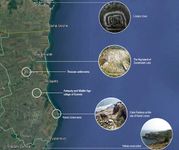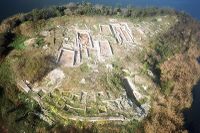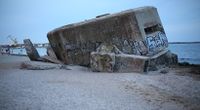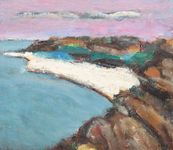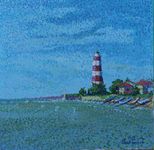Limanu-Shabla: Difference between revisions
| Line 40: | Line 40: | ||
== A.1 Landscape layers and their system context == | == A.1 Landscape layers and their system context == | ||
=== Geomorphology, landscape units and coastal typology === | === Geomorphology, landscape units and coastal typology === | ||
The southern sector of the Romanian coast, consisting mainly of cliffs formed of thick loess arranged above a discontinuous Quaternary red clay and Sarmatian limestone. There are discontinuous outcrops in the limestone base of the cliff and extending in the submerged area, forming a continuous submarine layer. | |||
The superficial sediments on the continental shelf are distributed according to actual hydrodynamic regime while retaining sediments and numerous relict bodies. Sands are found mainly near the shore and at a depth of 30-35 m. The superficial sediments at greater depths consist predominantly of clays and silt, with relict sedimentary sand bodies. | |||
Bulgarian shelf includes in its northern part a system of underwater sea terraces and smaller underwater sandy banks with depressions between banks. The underwater coastal slope is covered mostly by rocky banks overlaid by a dynamic sandy layer. In the coastal zone down to 1.5 m depth mostly sandy deposits prevail. The nearshore underwater slope is presented mainly from limestone, sands and sandstone. | |||
The habitats are characterized by sandbanks composed of sandy sediments in the form of deposits made up of boulders and cobbles, larger grain sizes and/or smaller grain sizes having tall shapes, oblong, rounded or irregular, permanently submerged and predominantly surrounded by deeper water. The biotopes are associated with sandbanks. | |||
Substrate located on a solid base (hard) or sedimentary (soft), which arise from the seabed in the infra-littoral and mediolitoral zone. Reefs are often associated with other habitats - permanently submerged sandbanks in shallow sections, marine caves and estuary habitats, sea arm components, and large shallow bays. In the Romanian sector of the Black Sea are present several categories of reefs. In Mangalia - Cape Aurora zone between 0 and 15 m deep, are located shallow sulfurous hydrothermal vents; in the 2 Mai - Vama Veche zone, in mediolitoral, there are rocky shores, with artificial habitats of rocks and boulders; Algal communities, brown, green and red, bivalve and shellfish populate there habitats. | |||
<gallery caption=" " widths="200px" heights="150px" perrow="5"> | <gallery caption=" " widths="200px" heights="150px" perrow="5"> | ||
Revision as of 20:34, 19 April 2018
>>>back to working groups overview
Rationale
- Why do you think this case is relevant? What is your hypothesis considering the landscape challenges?
- Format: 3-4 sentences
Location and scope
You can edit this map with the map editor
A Landscape System Analysis
A.1 Landscape layers and their system context
Geomorphology, landscape units and coastal typology
The southern sector of the Romanian coast, consisting mainly of cliffs formed of thick loess arranged above a discontinuous Quaternary red clay and Sarmatian limestone. There are discontinuous outcrops in the limestone base of the cliff and extending in the submerged area, forming a continuous submarine layer.
The superficial sediments on the continental shelf are distributed according to actual hydrodynamic regime while retaining sediments and numerous relict bodies. Sands are found mainly near the shore and at a depth of 30-35 m. The superficial sediments at greater depths consist predominantly of clays and silt, with relict sedimentary sand bodies. Bulgarian shelf includes in its northern part a system of underwater sea terraces and smaller underwater sandy banks with depressions between banks. The underwater coastal slope is covered mostly by rocky banks overlaid by a dynamic sandy layer. In the coastal zone down to 1.5 m depth mostly sandy deposits prevail. The nearshore underwater slope is presented mainly from limestone, sands and sandstone.
The habitats are characterized by sandbanks composed of sandy sediments in the form of deposits made up of boulders and cobbles, larger grain sizes and/or smaller grain sizes having tall shapes, oblong, rounded or irregular, permanently submerged and predominantly surrounded by deeper water. The biotopes are associated with sandbanks.
Substrate located on a solid base (hard) or sedimentary (soft), which arise from the seabed in the infra-littoral and mediolitoral zone. Reefs are often associated with other habitats - permanently submerged sandbanks in shallow sections, marine caves and estuary habitats, sea arm components, and large shallow bays. In the Romanian sector of the Black Sea are present several categories of reefs. In Mangalia - Cape Aurora zone between 0 and 15 m deep, are located shallow sulfurous hydrothermal vents; in the 2 Mai - Vama Veche zone, in mediolitoral, there are rocky shores, with artificial habitats of rocks and boulders; Algal communities, brown, green and red, bivalve and shellfish populate there habitats.
- Yourcase landscapeunits1.jpg
add a caption
- Yourcase landscapeunits2.jpg
add a caption
Land use
The costal concentration of tourism activities is in Limanu, where tourism investments have taken priority, resulting in a total number of 338 accommodation units. Shabla municipality is one of the least built villages and resorts (Durankulak, Krapets, Shabla and Ezerets) of the Bulgarian Black Sea coastal area and the urban tissue has not changed in the last decade, unlike the one on the Romanian seaside. The land-use includes the prevailing role of agriculture and forestry and relatively small urban use for housing, tourism, fishing and transport.
Compared to Limanu that is dependent on tourism for livelihoods, Shabla territorial unit is mainly oriented towards agricultural production. The development of Shabla economy is directed towards environmentally clean agricultural production and secondly on coastal tourism and recreation.
Other activities: beach camping, fishing activities that have suffered significant changes after 1980 in the structure of the fishing fleet and in operations because of the crisis of the resources and the new conditions of fishing in the former socialist countries, the marine aquaculture is developed only in the mollusk sector in the Bulgarian marine area, the military activities held by Romanian Navy inside and in the vicinity of the Mangalia port that affect the Mangalia marine area trough exercises for underwater operations and Shabla marine trough these military operations.
- Yourcase landuse1.jpg
add a caption
- Yourcase landscapeunits2.jpg
add a caption
- Yourcase landscapeunit3.jpg
add a caption
Green/blue infrastructure
A distinctive feature of this cross-border area is the existence of natural lakes and lagoons and meadow (Mangalia Lake, Shabla-Tuzla Costal Lake, Shabla and Ezerets Costal Lakes). Shabla Tuzla Coastal Lake is located approximately 6 km east of the town of Shabla. This lake is completely separated from the sea by a sand strip. It is a salt lake – lagoon, formed mainly by infiltration of saline waters beneath the sand dunes which separate it from the sea. At some 3 km from Shabla there is also the Shabla Lake, declared a protected area in 1979. Under this name are two natural coastal lakes in Shabla and Ezerets connected by an artificial canal. They are both separated from the sea by a strip of sand, 30-50 m wide. Together with Durankulak Lake the area is among the most significant wetlands in Bulgaria.
According to the data provided by Corine Land Cover during 2006, version 2013, the broad-leaved forest occupies a restrained surface on the cross-border Limanu - Shabla area. Forests often suffer negative impacts of tourism in the form of deforestation caused by fuel wood collection and land clearing. Coastal wetlands are frequently affected by the deforestation and intensified or unsustainable use of land, drained and filled due to lack of more suitable sites for construction of tourism facilities and infrastructure. These activities can cause severe disturbance and erosion of the local ecosystem, even destruction in the long term. Aside from direct effects, such as marine and coastal pollution and the introduction of invasive species are likely to result in more fragile marine ecosystems, making them more vulnerable to other environmental impacts resulting from, for example, the coastal deforestation. Further effects of deforestation include soil erosion and coastal flooding.
- Your case green blue infrastructure1.jpg
add a caption
- Your case green blue infrastructure2.jpg
add a caption
Actors and stakeholders
- Who is driving changes in this landscape? Who is affected by those changes?
- Draw a stakeholder and/or power map: Who is affected highly but with low power? Who has high power but is not affected?
- Your case your powermap.jpg
add a caption
Sacred spaces and heritage
In the Limanu – Shabla area, the Bulgarian coast’s history can be traced back to 7000 years ago: near Durankulak we can find the largest prehistoric necropolis studied in the world, from the 6th and the 5th millennium BC; there are multiple burial mounds grouped in mound necropolis complexes from the Bronze Age; from the Hellenistic Age we have the ancient fortress near Shabla, the sanctuary of the goddess Cybele on the Big Island of Durankulak Lake and Thracian settlements near the village of Vaklino; from Antiquity and Middle Ages – the villages of Vaklino and Ezeretz near Durankulak, Shabla, the Caria Fortress on the site of Karon Limen near Shabla.
The settlement discovered on the Big Island near the Druankulak Lake is believed to be the first sedentary agricultural culture in Europe, which created Europe’s first stone architecture. The most recent discovered stone building has an area of more than 200 square meters and two floors which means 400 square meters of combined built-up area. On the archeological site there have also been found remains from a Thracian settlement, dating back to 1300-1200 BC, around the time of the Trojan War, a 4th century BC rock shrine of Thracian Mother Goddess Cybele and a 9th-10th century AD fortress from the First Bulgarian Empire and an Ancient necropolis.
Near Limanu we can it is located the Limanu Cave, which represents a very important field for research and discoveries for the speleologists and historians. The cave has so many ramifications and winding galleries, that resembles to labyrinth difficult to penetrate, which is also the reason why the cave is still mysterious and has a lot of secrets that haven’t yet been discovered. So far there have been discovered altars, sculptures and rupestrian paintings, rooms shaped by the hand of man, Geto-Dacian ceramic vessels.
Southern from the village of Shabla there is the Archeological Reservation Yaĭlata, where it has been revealed a ‘cave town’, consisting of 101 dwellings dating from the 5th century BC, which are said to have been used for monastic purposes. Besides that, marks of the Byzantine age have been found, as well as the remains of a fortress.
Besides the historic heritage going back to the ancient times, in the cost east to Shabla have been found numerous shipwrecks (trade and military) in the maritime space, as well as near the coast east to Limanu.
Visual appearance and landscape narrative
Built by the Germans during the First World War, the Romanian coastline is studded with dozens pf dugouts, that were, after the war, strategically used in defending the coast from Cetatea Alba to Balchik, after Romania proclaimed its Independence and the harbors started to develop. After World War II, the entire defense system of the coastline was destroyed and now, the dugouts are only ruined witnesses of a long gone history. One of the dugouts is located in 2 Mai, in the Limanu commune, and the story says that here an entire squad would have died after a harsh fight and locals say that their spirits still haunt the place.
On the Bulgarian shore there is the Lighthouse at Cape Shabla, the oldest and the highest lighthouse in the country, older than 150 years and with a height of 32 m height. Painted in white and red, it protects the ships from colliding with a reef and prevents them from getting stuck in the shallows between Cape Shabla and Tyulenovo, flashing with white light three times every 25 seconds, that can be seen from 17 miles away. Locals regard the lighthouse as a smaller version of the Alexandria Lighthouse. There is also a story that more than 10 years ago, in the 1.20 meters thick walls of the building, a message has been hidden. It was to be opened by the future generations in 2056 and it contains data on the distance between the shore and the lighthouse. When it was measured, the distance was 13 meters, but according to the statistics in 1948, it was 29 meters. The guards of the lighthouse want this distance to be compared and measured in the years to come.
The coastline both in Romania and Bulgaria has always represented a subject for the landscape painting. Ion Pacea, Romanian modernist painter has been impressed by the seaside and had produced dozens of paintings inspired by the Romanian seaside, especially by the village of 2 Mai and the village of Vama Veche, in the Limanu commune. At the same time, the lighthouse in Shabla is not only important for guiding the ships, but structures the landscape and becomes subject for the artists.
A.2 Summary of you landscape system analysis and your development Targets
- You can summarize your findings with an DPSI(R) Model or a Spider Diagram
- Link back to the Sustainable Development Goals: Which goals are at risk?
- What is your hypothesis for this landscape?
- Visualise your hypothesis with one graphic/pict
- Are there any existing initiatives taking action in this landscape? Do you have a critical perspective on that?
- Add text and visuals
- Your case your hypothesis visual.jpg
explain your hypthesis briefly in the caption
A.3 Theory reflection
- Reflect on at least three international policy documents in relation to their local landscape case
- choose one international, one European and one national document
- You can choose references from our reading list
- Scope: 250 words
A.4 References
- http://www.marsplan.ro/images/documente/results/msp-mangalia-shabla/MSP%20Mangalia%20Shabla.pdf
- http://ziarullumina.ro/manastirea-limanu-ca-o-hozeva-dobrogeana-86323.html
- https://www.umblat.ro/evenimente-in/constanta/workshop/evaluarea-serviciilor-ecosistemice-ale-sitului-natura-2000-padurea-hagieni-cotul-vaii-73534#/
- http://neophron.com/gallery/scenery/
- http://about-eastern-europe.com/the-archeological-reservation-yailata-rezervatia-arheologica-yailata/
- http://www.imperialtransilvania.com/2018/02/12/read-more/argomenti/places-of-interest-1/articolo/limanu-cave-a-historical-labyrinth-monument-of-nature-covered-by-an-aura-of-mystery-on-the-man.html
- https://www.directbooking.ro/obiectiv-pestera-limanu-622.aspx
- https://www.saatchiart.com/art/Painting-lighthouse-Shabla-2015/809672/2617991/view
- https://www.romaniajournal.ro/the-underground-labyrinth-in-dobrogea-the-very-place-romanians-got-away-from-the-communists/
- http://www.thelivingmoon.com/46ats_members/Lisa2012/03files/Limanu_Cave.html
- https://www.natgeo.ro/natura/habitat-conservare/9855-petera-limanu-labirint-prin-istorie
- https://g1b2i3.wordpress.com/alexandru-ciucurencu-pictor-roman/ion-pacea-7-septembrie-1924-13-august-1999-pictor-roman/
- https://www.bg-guide.org/en/show-places/view/durankulak-lake
- http://archaeologyinbulgaria.com
- https://www.mirela.bg
- https://www.ziuaconstanta.ro/stiri/social/enigmele-marii-negre-epavele-din-apele-romanesti-456867.html
- https://steemit.com/travel/@victoria.tomova/durankulak-bulgaria
- http://www.wikiwand.com/ro/Litoralul_rom%C3%A2nesc
Phase B: Landscape Evaluation and Assessment
B.1 Assessment Strategy
- Based on the hypothesis derived from your previous landscape systems analysis you are now asked to define the goals for assessing the landscape. Your assessment is the basis for evaluating the landscape status.
- Which elements and phenomena need to be mapped, why and how?
- This a text contribution, max 250 words
B.2 Mapping
- As defined by your assessment strategy you conduct the mapping and present your findings here
- As a minimum, at least three different themes need to be mapped, you may choose more if needed
- Your case your assessment mapping themel.jpg
briefly explain the findings of your mapping
- Your case your assessment mapping theme2.jpg
briefly explain the findings of your mapping
- Your case your assessment mapping theme3.jpg
briefly explain the findings of your mapping
B.3 Problem definition and priority setting
- Give a summary of the major findings of your mapping process, what are the problems/potentials identified?
- Draw a problems/potentials map
- Set priorities for the most relevant issues
- Your case problems potentials map.jpg
add caption here
B.4 Theory reflection
- Please reflect the assessment and evaluation methods used based on at least three readings
- Did you encounter limitations'
- 200 words test contribution
B.5 References
- give a full list of the references you have used for this section
Phase C – Strategy and Master Plan
C.1 Goal Setting
- Define strategic planning objectives based on the evaluation findings
- Link back to your original targets from section one and the Development Goals
- 150 words text contribution
C.2 Spatial Strategy and Transect
- translate your strategic goals into a vision
- develop a spatial translation of your vision
- exemplify your vision in the form of a transect with concrete interventions
- add map(s) and visualizations
- Your case spatial translaton vision.jpg
add caption here
- Your case transect.jpg
add caption here
- Your case transect detail1.jpg
add caption here
- Your case transect detail2.jpg
add caption here
C.3 From Theory of Change to Implementation
- For implementing your vision: Which partnerships are needed? Which governance model is required?
- Who needs to act and how? Draw and explain a change/process model/timeline
- Which resources are needed? On which assets can you build?
- add 150 words text and visuals
- Your case spatial your governance model.jpg
add caption here
- Your case spatial your process model.jpg
add caption here
C.4 References
- give a full list of the references you have used for this section
D. Process Reflection
- Reflect in your intercultural and interdisciplinary team on the outcomes of your study
- Which limitations were you facing?
- What have you learnt from each other?
- What would you do differently next time?
- You can also use diagrams/visuals
- 250 words text

